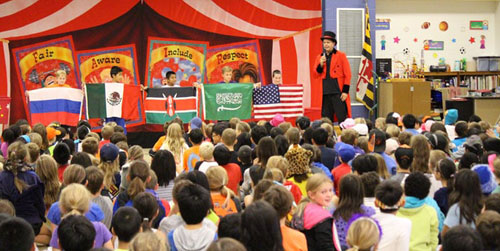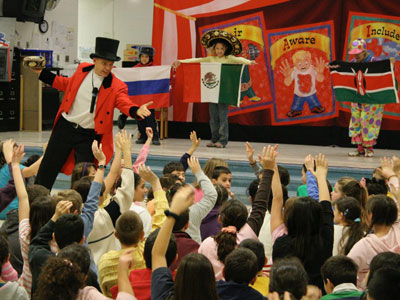
As a school show performer, I have a chance to visit schools not just in Michigan but all over the United States. When we travel to certain states, especially Maryland and the Washington DC area, we are privileged to perform our assembly programs to elementary kids from all walks of life, some english speaking and others who speak english as a second language. In our Diversity Circus assembly show we focus our lessons on being F.A.I.R. to all people and to not judge others. Sometimes, however it’s easy to jump to conclusions about others’ behaviors if their behavior doesn’t align with that of the majority of students.
English Language Learners (ELL) are both linguistically and culturally unique and diverse. Understanding that cultural differences can and do influence the behavior of your ELLs in a school will help you become a more effective and empathetic as a teacher. Let’s discuss eight ideas that all educators need to know when teaching students who are culturally diverse.

“Whether they come from different countries, cultures or faiths, all children are just children.”
— Kenneth Warshton, Author of Classroom Melting Pot
In the U.S.A. being timely to meeting and appointments is important but timeless is not as nearly important in other countries and cultures. The most noticeable differences can be found in particular Latin American, Southern European and Middle Eastern countries. Remember this when scheduling meeting and appointments with guardians or parents of ELLs. Families who arrive late may not even think they are late. Don’t expect an apology or advance warning of their tardiness. Parents and guardians might show up within 15-20 minutes last and consider that to be on time. In these instances, politely explain that in the future they should arrive as close to the actual appointment time as possible, especially if you maintain a tightly controlled schedule, like for conferences or if even during the school hours. When making an appointment, you could let it be known that it’s best if they’d come at the expected time. This allows everyone to have enough time for questions and discussions.
Some cultures do not engage in eye contact as often as Americans. This form of non-verbal communication can varies greatly among cultures. Many parents and students from the Puerto Rico and Dominican Republic don’t make direct eye contact during conversations. Instead, these ELLs will demonstrate respect by aiming their gaze down toward ground. Many people see looking away as being disinterested but that’s not entirely true in all cases. The lack of eye contact is the most common cultural misunderstandings in school. Some administrators or teachers will even show anger or impatience especially if correcting a child for something, and they may often say, “Don’t look away. Look up at my eyes when I’m speaking to you!” In many Asian, Middle Eastern and Latin American cultures, making direct eye contact looked down upon.
Proxemics is the notion of personal space or the measurable distance between people. In some South American countries and Eastern European areas along with Arab and Middle Eastern countries, people typically stand closer to one another than Americans do. This may make educators or pupils uneasy because they’re not accustomed to what appears to be a complete lack of acknowledging personal space. This makes Americans uncomfortable. But the direct opposite of this is also true – people from other countries typically stand father apart when engaging in conversation.
In East Asian cultures, students are assumed they will sit quietly and listen to their teacher always. This is true of other cultures as well. The teacher is respected as the expert and it would be rude for students to defy the teacher by questioning anything that the teachers says. In North American class’s students will actively offer opinions, ask and help to answer questions through encouraged participation. If an ELL child is waiting quietly and paying attention, it’s important to acknowledge this is not disinterest in the lesson but rather respectful behavior.
Often in American classrooms, when homework is assigned, the common understanding is that children will do their work by themselves unless it’s intended or encouraged to be a group assignment with fellow students or with family help. But in cultures outside the US, the idea of the group is more important than the idea or of the individual so assisting others in completing homework is an encouraged and acceptable activity. Many Caribbean children often share their assignments and let their friends copy their replies. They don’t see this as being wrong or as cheating in any way. Of course, a teacher must point out that homework needs to be done individually unless otherwise instructed. Sharing of answers could be considered cheating.
In 1964, the American linguist Bob Kaplan wrote a study detailing five styles of writing then grouped them from where the author came. He differentiated the rhetorical styles between English, Romance, Semitic, Asian and Russian. Even though his conclusions have been challenged, the main observation that people from various cultures use diverse rhetorical styles is still valid. What this for a teacher is that students in a diverse classroom will use language arts differently. For example some students will write quotation or punctuation marks untraditionally (slanted quotation marks are used in France and a period is regularly put outside the quotation mark in British English), but how students structure writing will likely be different from the method elementary kids are taught in the United States.
In Ancient China, scoring high on a civil service exam to earn the job of a governmental officer meant being capable of exactly duplicating what Chinese philosophers and scholars had recorded in previous ages. So the concept of plagiarism is very different in some cultures. The reward for exactly copying means that in Asian, as well as some other cultures, being able to plagiarize is perceived very differently. It shows a high level of study. Unless clearly explained, often ELLs may not recognize that copying from others’ works is not acceptable in U.S. schools. When instructing kids from other countries, defining and giving examples of how to cite other’s work properly will help students recognize how to avoid embarrassment and avoid the act of plagiarism.
For kids who are less proficient in English, using their second language, English, all day in school or classes can be exhausting for ELLs. When students use their native dialect with their friends or family, it’s usually simply because it’s simpler and quicker for them to express themselves. Some students can think ELLs are telling secrets about them when they hear another language but that is quite rarely the truth. Sadly, some teachers and staff members will chastise ELLs, requesting that they speak English. But in a 2014 memorandum from the Departments of Education, teachers were reminded that they “should not prevent national origin-minority students from using their native language during school hours without a justification based on educational goals.”
Teachers can make culturally-diverse children feel more accepted by their peers by doing simple things in the classroom. One method of encouraging acceptance of students’ native languages is by displaying greetings in other languages in the classrooms or in the main hallway of your school.
Of course, it would certainly be a big chore for a teacher to become familiar with the minutia of each culture represented if a classroom has students from many countries. But knowing what a few of the major differences are among your students’ backgrounds and cultures will help you become a better instructor for your culturally diverse students. By teaching in a culturally aware manner pupils will become more successful.


If you’d like to learn more about how we work best with kids from other cultures or how we present the ideas of acceptance and understanding to make your school a more inclusive place, please check out our Diversity Circus assembly show for elementary schools.